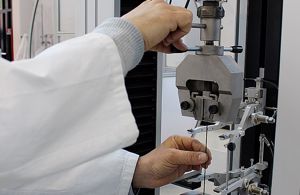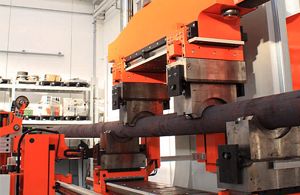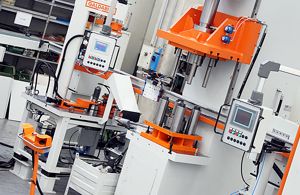-
Product Lines
Material testing machines for quality control

Automatic straightening machines for shafts, profiles

Hydraulic presses, Trimming beading and Automatic production lines

- Company
- Service
- Calibration
- Community
- Contacts
- Library
ASTM E23, ISO 148-1, ASTM A370-NIST
ASTM A370 also includes Charpy impact test method requirements but focuses only on steel products. All three standards provide details for properly measuring the energy absorbed by the notched specimen when impacted by a swinging pendulum. A typical Charpy test requires the notched metal specimen to rest on supports at each end (in a horizontal way) while coming in contact with vertical anvils adjacent to the supports. The specimen is then struck opposite the anvils at its centerline by a striker that is attached to a swinging pendulum (hammer).
In order to measure the toughness of a material using a Charpy impact test, it is necessary to obtain specimens from the material or product of interest. Normally, specimens are 55 mm long with a 10 x 10 mm section and a central V-notch of 2 or 3.3 mm or a U-type of 5 mm. The standard also allows reduced section specimens 10 x 7.5 or 10 x 5 and in this case special thicknesses to be interposed between the supports and the specimen to assure the perfect striker stroke axiality have to be provided.
Impact is a particularly safe instrument with solutions exceeding standard requirements, for example the metal bar that mechanically stands between the armed pendulum rod and the area where the operator manually loads the specimen. The fully interlocked protection guard is also available with two access doors for easy retrieval of post-test specimen parts. Transparent lexan panels permit the operator to view the impact test. The machine includes a motorized return of the hammer to the release point to eliminate any operator lifting of the hammer preventing injury.
ASTM E23 details the requirements for impact testing of Charpy specimens. Additionally, the application we were asked to perform required NIST (National Institute of Standards and Technology) certified results. Since NIST requires that the specimens be cooled to -40° C and then tested at that temperature, it is necessary to have a cooling bath for high series energy breaks. As soon the test is done, it is necessary to send NIST our documentation that includes the impact energies of each specimen along with the broken specimens for certification review. We can expect either certification (pass) or a failure report that includes suggestions for modifications to meet the next NIST certification attempt. These procedures can be submitted to the Galdabini Service Center that will handle the entire procedure. BCR certified specimens are also available for measuring instrument accuracy checking.
Charpy pendulums are available in different sizes of 150, 300, 450 or 750 Joule and can be supplied complete with plinth in pre-compressed material to avoid customer foundation works.